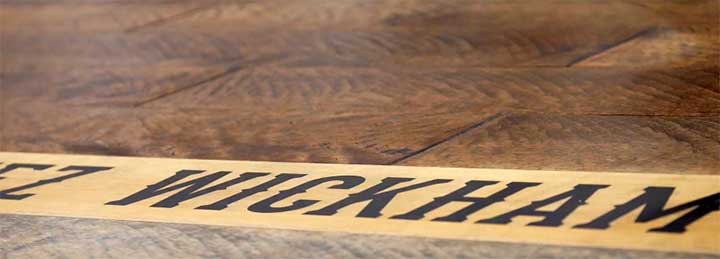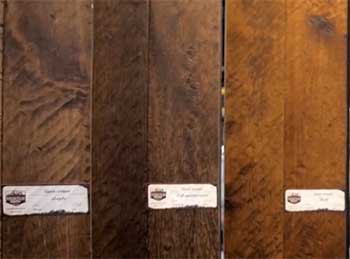Wickham flooring has become a popular brand for homeowners looking for durable and stylish flooring options. However, despite its reputation, Wickham products have been the subject of numerous complaints over the years.
In this comprehensive guide, we’ll take an in-depth look at the most common grievances customers have with Wickham floors, from installation problems to quality control issues. Read on to learn the key things to watch out for if you’re considering Wickham for your next flooring project.
Common Wickham Flooring Complaints

Here is a list of those problems:
- Difficulties with Installation
- Quality Control and Consistency Issues
- Durability Not Meeting Expectations
- Difficulties with Repairs and Replacements
- Poor Resistance to Indentations
- Trouble Sanding and Refinishing
- Excessive Hollow Sounds
Let’s talk about those issues in detail.
Difficulties with Installation
One of the most frequent complaints about Wickham flooring is that it can be tricky and time-consuming to install properly. Here are some of the key installation challenges customers report:
- Subfloor preparation problems – Wickham floors require an extremely smooth, flat subfloor to look their best. But many customers find their subfloor needs more leveling and patching than expected, complicating the installation.
- Planks not clicking together cleanly – Wickham uses a “click” system to connect its engineered wood planks together without glue. But owners say the planks don’t always fit tightly together, leaving annoying gaps between boards.
- Difficulty nailing planks in place – The company recommends adding nails to secure planks along walls and transitions. However, consumers say hammering nails through Wickham planks is tough without splitting the wood.
- Cutting planks requires special saws – You can’t cut Wickham floors using just any saw. The company says you need specialty saws designed for laminate to avoid damaging planks. This adds hassle and expense for DIYers.
- Excessive hollow sounds underfloor – Even when installed correctly, Wickham floors often have a hollow, cheap sound when walked on, owners report. This detracts from the rich hardwood sound many customers expect.
Careful subfloor prep and following Wickham’s specific installation guidelines can help minimize issues. But the extra installation demands leave many buyers frustrated, especially when competing brands don’t have the same requirements.
Quality Control and Consistency Issues
Another common grievance from Wickham customers relates to quality control and product consistency problems. Some of the main complaints in this category include:
- Fading and discoloration – Some Wickham flooring lines have received complaints about the floor losing vibrancy and changing to a different shade over time, especially with sun exposure. This makes the flooring look worn and dated prematurely.
- Chipping and scratching – While durable overall, some buyers say their Wickham floors show cosmetic scratches and chips more readily than expected for an engineered wood product. This detracts from the long-lasting appearance they anticipated.
- Repeat patterns obvious – Wickham’s digital printing process for emulating wood grain has received criticism for making plank patterns look obviously repetitive and artificial in some homes, damaging the realistic wood look.
- Differences between samples and installed floors – Customers have reported their installed floors being a noticeably different hue or grain pattern than the samples they approved. This suggests potential QC issues at the manufacturing stage.
While no flooring product is perfect, the number of complaints related to quality and consistency issues indicates room for improvement in Wickham’s production processes and quality control. Many owners say these problems detract from the premium price charged for Wickham floors.
Durability Not Meeting Expectations
Wickham promotes its flooring as sturdy and long-lasting in residential settings. But various customer experiences suggest the durability is not always as robust as advertised. Here are some of the most common durability complaints:

- Dents from pet claws and furniture – Many pet owners report noticeable dents, scratches, and gouges from dog and cat claws that make floors look worn despite careful maintenance.
- Problems near radiant heating vents – Some styles of Wickham flooring warp, expand, and delaminate when installed over radiant heating vents, owners warn. This can ruin planks near heat sources.
- Premature wear in high-traffic areas – Heavy traffic zones like hallways and kitchens show damage, thinning, and discoloration sooner than expected, customers say, indicating the floors may not withstand decades of regular use.
- Moisture damage near doors and appliances – Despite claims of waterproof engineering, some buyers experience planks swelling, degrading, or buckling due to moisture near front doors, dishwashers, and other sources.
While no flooring lasts forever, Wickham customers caution that the durability and water resistance of these floors does not always align with expectations and advertising. This leaves many buyers disappointed with the value proposition.
Difficulties with Repairs and Replacements
A final pain point reported by Wickham customers involves challenges dealing with repairs and replacements when problems do arise. Key repair and replacement complaints include:
- Lack of local retailer support – Because Wickham sells direct online, there are no local flooring stores to help troubleshoot and resolve issues. Consumers must deal directly with corporate reps by phone or email, which some find frustrating.
- Sparse local installer network – Wickham has a limited network of approved local installers customers can hire for repairs or new installations. In some areas, there may be no recommended pros available, making issues harder to resolve.
- Strict requirements on repurchasing flooring – Customers say Wickham imposes strict limits on re-ordering flooring for repairs. The brand requires buyers use an authorized installer and provide extensive documentation proving the flooring failed prematurely.
- Extended wait times – Even when warranty claims are approved, owners report having to wait weeks or longer for replacement flooring. This leaves homes unusable or with damaged floors for extended periods.
While Wickham does offer warranties on its flooring, the red tape and delays involved in addressing issues leave many customers feeling let down and abandoned when problems arise.
Poor Resistance to Indentations
Many Wickham owners report issues with flooring planks denting and showing indentations more easily than expected. Problems include:
- Furniture legs leaving permanent dents and impressions over time, even with felt pads attached
- High heels and narrow chair legs pressing into planks, damaging the surface
- Heavy appliances like refrigerators and stoves causing visible depressions and damage, even on concrete subfloors
- Planks developing recessed areas and loss of structural integrity in high traffic zones
Compared to natural hardwood or higher-end engineered wood, Wickham floors seem prone to dents and impressions under typical residential use. Many owners feel the density and thickness of the planks do not provide sufficient dent resistance for decades of family living.
Trouble Sanding and Refinishing
While marketed as floors that can be refinished multiple times, Wickham products receive complaints about the challenges of sanding and refinishing compared to solid wood. Issues include:
- Very thin wear layer on some planks that cannot withstand deep sanding
- Difficulty removing damaged finish layers without reducing planks below minimum thickness
- Gaps appearing between planks after sanding since connections loosen over time
- Uneven sanding since planks have different densities and thicknesses
- Finish not absorbing evenly across planks, resulting in splotchy appearance
Customers caution that the refinishability of Wickham floors is not as simple or effective as with traditional hardwoods. The complex layered construction leads to unsatisfactory sanding and refinishing outcomes for many buyers.
Excessive Hollow Sounds
A common complaint about installed Wickham floors is that they produce an unusually loud, hollow sound when walked on. Problems noted by owners include:
- Floor has a cheap, artificial echo even over plywood and concrete subfloors
- Hard heels or heavy footsteps produce loud clicking noises radiating across floor
- Hollow amplified sound detracts from the solid hardwood acoustic experience expected
- Uncomfortable levels of noise transferring to rooms below the floors
While the installations meet guidelines, the lightweight layered construction of Wickham’s engineered flooring lacks the density and mass needed to reduce noise. Many owners add rugs and runners to dampen the pronounced hollow sounds.
Top Buyer Recommendations For Wickham Floors
Based on common complaints and issues, here are our top tips for consumers considering Wickham flooring:
- Inspect the subfloor thoroughly and make all recommended preparations – don’t cut corners to reduce installation time or costs.
- Review the flooring closely before installation and during the process. Reject planks with any imperfections or inconsistencies.
- Add an extra moisture barrier and use the recommended adhesives if installing near exterior doors or in bathrooms and kitchens.
- Consider professional installation, especially if you don’t have experience installing engineered wood floors.
- Purchase a few extra boxes for future repairs and keep leftover planks. Don’t rely on being able to reorder down the road.
- Avoid the thinnest Wickham floors (5mm planks) for high-traffic areas or if you have large pets at home. Go with a slightly thicker profile for added durability.
- Buy from a retailer that offers price-matching on Wickham to ensure you get the best deal.
While no brand is perfect, being an informed shopper can help you avoid the most common headaches reported with Wickham flooring. Weigh the benefits and potential drawbacks before purchasing to make sure it’s the best choice for your home and lifestyle.
Frequently Asked Questions About Wickham Flooring
Here are answers to some of the most commonly asked questions about Wickham flooring:
Hardwood floors like oak and maple have remained popular and timeless options for decades, as has ceramic tile. Both offer durability and classic styling that suits a wide variety of home d├ęcor.
Luxury vinyl plank is generally the most durable and scratch-resistant option that mimics the look of real wood. Made from tough PVC, luxury vinyl stands up better to pets, kids, and heavy traffic than laminate or engineered wood.
Hickory is very dense and durable, but more susceptible to dents and scratches than oak or maple. The rustic grain pattern also shows dirt, dust, and wear more visibly than options with smoother grains. And the hard density can lead to installation challenges.
Red oak is often cited as the best all-around wood flooring for residential use. It’s durable enough for active homes but not as costly as exotic woods. The pleasing visual grain provides timeless warmth and beauty. Durable finishes help it hold up for decades.
In Conclusion
While Wickham offers stylish, modern flooring options, the brand has received numerous complaints over quality control, durability, and customer support issues. Careful inspection and preparation during installation along with tempered expectations about long-term wear and tear can help consumers make the most informed choice.
Weigh both benefits like unique visuals and potential drawbacks before purchasing Wickham floors. With realistic expectations, buyers can make the best decision to suit their budget and home.
For other great flooring brands, consult with knowledgeable retailers to compare options and see samples firsthand before you decide.
